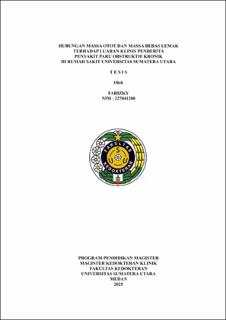Hubungan Massa Otot dan Massa Bebas Lemak Terhadap Luaran Klinis Penderita Penyakit Paru Obstruktif Kronik di Rumah Sakit Universitas Sumatera Utara
The Relationship Between Muscle Mass and Fat-Free Mass With Clinical Outcomes in Patients with Chronic Obstructive Pulmonary Disease at Universitas Sumatera Utara Hospital

Date
2025Author
Farizky
Advisor(s)
Pradana, Andika
Permatasari, Amira
Amelia, Rina
Metadata
Show full item recordAbstract
Background: Chronic Obstructive Pulmonary Disease (COPD) is a chronic and progressive lung disease characterized by airflow limitation, chronic cough, and an increased risk of mortality in affected individuals. The abnormal musculoskeletal condition of COPD patients is associated with increased inflammatory activity, leading to significant impairment. This inflammatory condition is associated with progressive muscle mass loss among the COPD population. Furthermore, several studies have found that muscle mass reduction is linked to worse outcomes in COPD patients.
Objective: This study aims to analyze the relationship between muscle mass and fat-free mass with the clinical outcomes of stable COPD patients, as assessed by Forced Expiratory Volume in one second (FEV₁), mMRC classification, and exacerbation history.
Methods: This cross-sectional study was conducted at the Pulmonary Outpatient Clinic of the Universitas Sumatera Utara Hospital, Medan, Indonesia. The sampling technique used was consecutive sampling based on inclusion and exclusion criteria. The inclusion criteria were stable COPD patients diagnosed through spirometry and confirmed via medical records from the Universitas Sumatera Utara Hospital. Patients with significant restrictive or obstructive abnormalities and those who had undergone thoracic-cardiovascular surgical procedures were excluded from this study.
Results: This study involved 67 participants diagnosed with stable COPD. Bivariate and multivariate analyses of several independent variables (age, gender, body mass index/BMI, muscle mass, and fat-free mass index/FFMI) with clinical outcome variables, such as GOLD and mMRC classification, did not find any significant relationship (p-value <0.05). However, exacerbation history was identified as an intermediary variable in this study. Exacerbation was significantly associated with age over 60 years (p-value 0.038), GOLD classification (p-value 0.000), and mMRC classification (p-value 0.000) in bivariate analysis. Further multivariate analysis found that decreased muscle mass, increased mMRC classification, and GOLD classification increased the risk of exacerbation, with Adjusted Odd Ratios of 0.137, 21.407, and 5.451, respectively.
Conclusion: Muscle mass reduction is significantly associated with mMRC classification and exacerbation events. Therefore, interventions aimed at increasing muscle mass are beneficial in improving patient outcomes.
